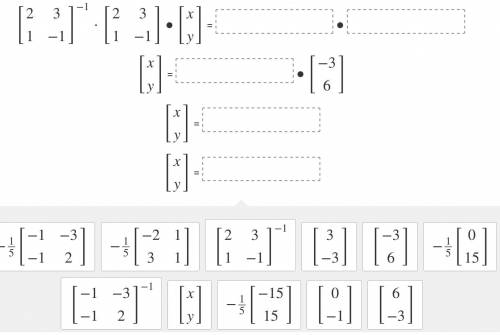Dante solves the system of equations by forming a matrix equation.
2x+3y=−3
x−y=6
...

Mathematics, 29.10.2020 05:20 juliannabartra
Dante solves the system of equations by forming a matrix equation.
2x+3y=−3
x−y=6
He multiplies the left side of the coefficient matrix by the inverse matrix.
How does he proceed to the solution?
Drag the choices to correctly complete Dante's process.


Answers: 1


Other questions on the subject: Mathematics

Mathematics, 21.06.2019 18:30, allenlog000
Can someone me out here and the tell me the greatest common factor
Answers: 1

Mathematics, 21.06.2019 21:30, amesha62
In a test for esp (extrasensory perception), a subject is told that cards only the experimenter can see contain either a star, a circle, a wave, or a square. as the experimenter looks at each of 20 cards in turn, the subject names the shape on the card. a subject who is just guessing has probability 0.25 of guessing correctly on each card. a. the count of correct guesses in 20 cards has a binomial distribution. what are n and p? b. what is the mean number of correct guesses in 20 cards for subjects who are just guessing? c. what is the probability of exactly 5 correct guesses in 20 cards if a subject is just guessing?
Answers: 1

Mathematics, 22.06.2019 02:10, matthewlucas8499
Which pair of expressions is equivalent? a 7(1–k)and7–k b 7(1–k)and1–7k c 7(1–k)and7–k d 7(1–k)and7–7k
Answers: 1

Mathematics, 22.06.2019 02:30, misk980
Atrain traveled for 1.5 hours to the first station, stopped for 30 minutes, then traveled for 4 hours to the final station where it stopped for 1 hour. the total distance traveled is a function of time. which graph most accurately represents this scenario? a graph is shown with the x-axis labeled time (in hours) and the y-axis labeled total distance (in miles). the line begins at the origin and moves upward for 1.5 hours. the line then continues upward at a slow rate until 2 hours. from 2 to 6 hours, the line continues quickly upward. from 6 to 7 hours, it moves downward until it touches the x-axis a graph is shown with the axis labeled time (in hours) and the y axis labeled total distance (in miles). a line is shown beginning at the origin. the line moves upward until 1.5 hours, then is a horizontal line until 2 hours. the line moves quickly upward again until 6 hours, and then is horizontal until 7 hours a graph is shown with the axis labeled time (in hours) and the y-axis labeled total distance (in miles). the line begins at the y-axis where y equals 125. it is horizontal until 1.5 hours, then moves downward until 2 hours where it touches the x-axis. the line moves upward until 6 hours and then moves downward until 7 hours where it touches the x-axis a graph is shown with the axis labeled time (in hours) and the y-axis labeled total distance (in miles). the line begins at y equals 125 and is horizontal for 1.5 hours. the line moves downward until 2 hours, then back up until 5.5 hours. the line is horizontal from 5.5 to 7 hours
Answers: 1
You know the right answer?
Questions in other subjects:


Mathematics, 24.02.2021 01:00

Mathematics, 24.02.2021 01:00

Social Studies, 24.02.2021 01:00


History, 24.02.2021 01:00

Mathematics, 24.02.2021 01:00

Biology, 24.02.2021 01:00

English, 24.02.2021 01:00

Mathematics, 24.02.2021 01:00



